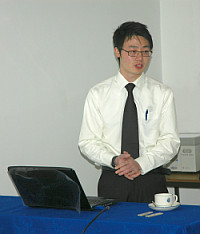 Dr Zhiwei Fu from Dundee University gave a talk on the stability of breakwaters due to pore pressure variation caused by waves. The talk described wave model development coupled to a soil analysis program which computes the pore pressure values.
Dr Zhiwei Fu from Dundee University gave a talk on the stability of breakwaters due to pore pressure variation caused by waves. The talk described wave model development coupled to a soil analysis program which computes the pore pressure values.
Many offshore structures are affected by the effect of the waves on pore pressure and this can lead to major disasters in oil platforms and breakwater type structures. The wave throw has the effect of producing suction in the soil, which can lead to liquefaction and loss of stability.
Zhiwei worked with poroelastic models that took into account plastic effects. The model has been used before for the case of regular waves but not for random wave analysis. His research concentrated on the case of breakwater structures for which reflected waves need to be considered.
A finite element model was used to model the wave. The input was random as defined by the classical spectra (ie Jonswar and B-M). Water action and dynamic wave pressure were obtained using these spectra.
The research was carried out using a dynamic wave program developed at the University of Birmingham. When applied to the poroelastic models one finds that the plastic models results produce higher volumes of pore pressure than electric simulation. Hence elastic models may underestimate the liquefaction potential.
Case studies presented demonstrated the possibility of liquefaction appearing at the end of a breakwater. In order to avoid this problem one needs to change the soil material permeability. The relationship between soil permeability and poroelasticy has been studied in detail by Zhiwei.
The lecture was followed by a lively question and answer session.

 Wessex Institute
Wessex Institute